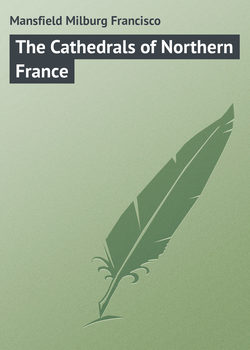Читать книгу The Cathedrals of Northern France - Mansfield Milburg Francisco - Страница 5
PART I
Transition Examples
II
NOTRE DAME DE LAON
ОглавлениеFor over twelve hundred years, until the see was abolished at the Revolution, Laon was the seat of a bishop who in point of rank was second only to the primate at Reims. Crowning the apex of a long isolated hill, upon which the entire town, now a fortress of the third class, is situated, the cathedral of Notre Dame de Laon, still so called locally, has endured since the beginning of the twelfth century, and may be considered a thoroughly representative transition example.
The present structure is on the site of one burned in 1112, and during comparatively recent years has been entirely restored.
Its crowning glory is in the disposition and number of its fine group of towers: two flank the western façade, and are rectangular at the base, dwindling to a smaller polygon, which is flanked with corner belfries and pierced by a tall lancet in the central structure, showing a wonderful lightness and open effect. A curious and unique feature of these towers is the addition of four oxen in carven stone perched high aloft in the belfries. These sculptured animals may be merely another expression of symbols of superstition, and if so are far more pleasing than some of the hideous and monstrous gargoyles ofttimes seen. Two other towers, each 190 feet in height, adjoin the transepts, to each of which is attached a double-storied, apsidal, ancient chapel. Two similarly projected towers are lacking. The lantern is square, with a shallow, conical, modern roof.
In the transition type Romanesque influences were evidently dying hard. The Gothic was seldom full blown, and at Laon shows but the merest trace of pointedness to the arches of the western façade, either in the portals or in the higher openings.
The lack of a circular termination to the choir is but another indication of a link with a transitory past; an undeniably false note and one very unusual in France, the choir being of the squared-off variety so common in England. This may be coincident with the English custom of the time, or it may be directly due to a local English influence; – most probably the latter, inasmuch as an English prelate held the see for a time, and the city, in the early fifteenth century, was for a number of years in English hands. It is significant that in some of the smaller churches of the diocese is to be noted the same treatment.
The rose windows of both the eastern and western façades are Gothic in inception and treatment, and are unusually acceptable specimens of these supreme efforts of the French mediæval builders, the glass therein being distinctly good, though perhaps not remarkable.
The transepts are rectangular and, with the ensemble of the entire structure, were their towers completed, there would be produced, not only a unique example, but a towering effect only a degree less interesting than the perfectly proportioned pyramidal form so much admired in the perfectly developed Gothic.
The interior is equally attractive with the exterior, and, though the church is not by any means of remarkable dimensions, it presents in its appropriate disposition of detail a far more roomy and pleasing arrangement than many a larger example.
The transepts are divided into a nave and side aisles, the columns which partition them, like those of the nave proper, being cylindrical and of massive proportions, which, however, lighten as they rise to the vaulting. They are unusually symmetrical when viewed together, the capitals of the lower series being ornately carved, each of a varying design.
Above the aisles are lofty galleries. The nave chapels were added in the sixteenth and seventeenth centuries. The stained glass, like that of the rose windows, is in the nave distinctly good, particularly that of the lower range on the southerly side. The pulpit, of carved wood of the Renaissance period, is not of the importance and quality of this class of work to be seen across the Rhine border.
The former Bishop's palace, adjoining the left of the choir, is now the Palais de Justice. A few remains of a former Gothic cloister are to be remarked, surrounded by the later construction.
